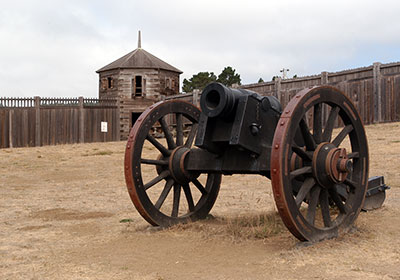National Register of Historic Places in Sonoma County
Fort Ross
19005 Coast Highway
Fort Ross State Historic Park
Founded 1812
In the 1740's, the Russian American Fur Company controlled Alaska. In search of the prized otter and spurred by the lack of food supplies at Sitka, the Russians extended their operations to the coast of Spanish California.
After a number of exploratory voyages, Ivan Alexandiovich Ruskof arrived in 1812 with about a hundred Russians, and nearly that many Aleutians, and began construction of Fort Ross. A stockaded fort was constructed. Conservative estimates suggest that the buildings numbered more than fifty and that the population at one time was about four hundred.
Although Fort Ross was situated within territory claimed by the Spanish Crown, from 1812 until 1841 it was a center of Russian otter hunting, fur trading, and agriculture.
By 1841, Russia realized that Fort Ross could not be maintained profitably and sold everything but the land to John Sutter for $30,000. (Russia did not claim ownership of the land) Russia evacuated the post early in 1842.
When it was placed on the National register, Fort Ross consisted of two reconstructed blockhouses, the restored Commandant's House, the restored chapel and a reconstructed stockade enclosing the buildings. It is picturesquely situated on a small shelf on a bluff overlooking the Pacific Ocean, hemmed in by grassy hills. The chapel building, although not a completely accurate restoration, contains a considerable portion of the original chapel and is a fine example of Russian construction.
The Russian Orthodox chapel was built about 1825. Sparsely furnished, and used only occasionally there was no regular priest at Ross--the building remained standing long after the Russians left California. Then during the 1906 earthquake, its walls collapsed. The chapel ivas restored in 1916-17 and more authentically in 1955-56, only to be completely destroyed by fire in 1970. Following this tragic event, the chapel was once again resurrected. One of the original Russian bells, completely melted by the fire, was recast for display.
The original blockhouses and some parts of the stockade remained standing until the 1906 earthquake, and so it has been possible to reconstruct them with a high degree of accuracy, using original materials to some extent. Made entirely of hand-hewn redwood timbers set two feet in the ground, the 12-foot high stockade included three sally-ports that provided the only entrance to the stockade. Brass and iron cannons were placed in the blockhouses and also defended each sally-port. Some descriptions say that the chapel also served as a bastion, and that brass cannons were mounted on either side of the altar.
During the Russian period, 40 to 50 buildings stood outside of the stockade. These included a number of high-roofed cottages for the Russian members of the community, as well as the flat-topped houses of the Kodiak Islanders or Aleuts, and some coneshaped dwellings and dance houses built by the Porno people associated with Ross. These buildings were scattered around the fort on both the seaward and more protected north and east sides. Down in the ravine were several important work buildings including one large building (60* x 80' x 100'), that housed the tannery and boat shop. Several ocean-going ships were built at Ross in the early 1820's.
On the flat, east and south of the ravine, were several carefully fenced agricultural fields, and a monument-filled cemetery. Other important'out-buildings included a bath house and a large windmill on the knoll northwest of the fort near the present day parking lot.
From the National Register nomination dated 5 November 1961.

Both Fort Ross and the Fort Ross Commander's House are National Historic Landmarks. Fort Ross is also California Historical Landmark 5.
